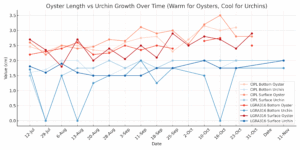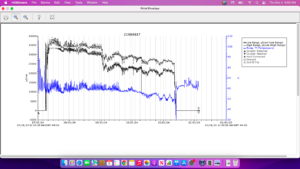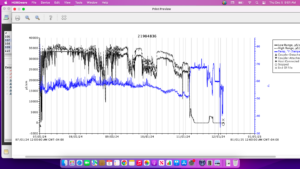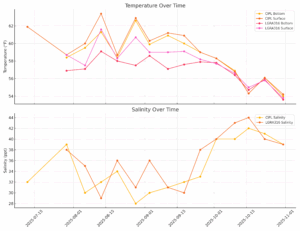Final report for FNE24-082
Project Information
The purpose of this project was to evaluate whether co-culturing oysters (Crassostrea virginica) with green sea urchins (Strongylocentrotus droebachiensis) could improve oyster growth, reduce biofouling, and support the cultivation of urchins as a secondary crop.
We conducted field trials at two farm sites—an inner, warmer site (CIPL) and an outer, colder site (LGRA316)—using both surface and bottom cages. Each 9mm mesh bag was stocked with ~2 liters of oysters (1.5–2" long) and two urchins. Growth and survival of both species were monitored weekly from July to November, alongside temperature and salinity measurements using HOBO loggers and manual tools. At the end of the season, all gear was harvested, biofouling assessed, and cages were sunk for overwintering, with survival checked again in spring.
Results showed high survival for both oysters and urchins across all treatments, including overwintering, with no major die-offs. Oysters grew from an initial size of 1.5–2" to an average of 2.9–3.14", with the largest oysters at the inner site surface gear. However, oysters grown without urchins and managed traditionally by weekly flipping averaged ¼–½" longer than co-cultured oysters, showing that biofouling control by urchins was ineffective compared to sun-drying. Urchins survived the season but showed minimal growth, suggesting limited nutritional gain from fouling inside bags. Heavy sea squirt fouling clogged the 9mm bags, especially in surface gear, reducing usability and water flow. Environmental conditions influenced outcomes: inner site waters were ~2°F warmer in summer and correlated with slightly better oyster growth.
Overall, we concluded that while oysters and urchins are biologically compatible in co-culture with high survival, the method is not yet practical for reducing biofouling or enhancing oyster growth under current gear setups. Future improvements may require bottom-only configurations or alternative culture systems to make the approach viable.
For outreach, we hosted three on-farm tours, shared results through a poster circulated to ~900 growers, aquaculture professionals, and educators, and published findings on our farm website and social media, reaching more than 1,500 followers. Additionally, five farmers directly participated in the trials, and several others reported increased knowledge and awareness as a result of engagement with this project.
Project Objectives:
Assessing the Co-Culturing of Oysters and Urchins:
- Evaluate whether rearing oysters and urchins together improves survival rates for either species, and if so, identify the mechanisms behind any synergistic effects.
Impact of Environmental Fluctuations:
- Investigate how variations in temperature and salinity affect the survivorship and growth of both oysters and urchins when cultured together.
Comparing Grow-Out Gear Types:
- Examine the effectiveness and user-friendliness of two types of grow-out gear (bottom vs. surface) in cultivating oysters and urchins together.
- Analyze whether one type of gear results in better survival and growth for either species.
Biofouling and Growth Relationships:
- Assess whether urchins contribute to reducing biofouling on grow-out gear or oyster shells, and if so, determine the impact on oyster growth and farming efficiency.
Overwintering/ Hibernation Survival:
- Evaluate the ability of oysters and urchins to survive through the annual overwintering process, from November to April, and the potential impact on long-term cultivation success.
Introduction:
As aquaculture grows along the Maine coast, most farms remain focused on monoculture, particularly single-species oyster production. This project explores the potential benefits of co-culturing green sea urchins (Strongylocentrotus droebachiensis) with oysters (Crassostrea virginica) as a strategy to improve farm efficiency and sustainability. Urchins are natural grazers of biofouling organisms like algae and encrusting invertebrates, which significantly impact oyster farm labor and gear maintenance. By integrating urchins into oyster grow-out systems, farmers may reduce biofouling, enhance oyster growth, and cultivate urchins as a secondary market crop. The study investigates survivorship and growth under varying environmental conditions (temperature, salinity, gear type), aiming to identify whether polyculture can improve outcomes for both species while promoting a more resilient, diversified aquaculture model.
Aquaculture is rapidly expanding along the Maine coast, but most farms remain focused on single-species production, creating a monoculture farming model. The equipment, grow-out gear, and farming processes are all species-specific, limiting the potential for diversification. However, the farming of urchins alongside oysters presents an opportunity for mutual benefit. Urchins naturally feed on algae, kelp, and biofouling organisms that accumulate on oyster farms, including encrusting pests and competing filter feeders. Previous studies have shown promising results in co-culturing urchins with shellfish, with urchins effectively reducing biofouling by up to 50% (McBride, 2005; Harris, 2014).
One of the most labor-intensive aspects of oyster farming is managing biofouling. Farmers spend significant time—at least 50% of their work hours, or roughly 100 hours each week—manually removing seaweed, barnacles, and other fouling organisms from gear and oyster shells. If urchins can reduce biofouling by even 50%, this could save oyster farmers as much as $1,000 per week in labor and fuel costs. Additionally, urchins could provide a secondary market product, such as Maine-grown uni, which currently retails at $35 per 2.8 oz tray (SOPO Seafood, 2023). This could increase farm profitability, making oyster farming more financially viable and efficient.
The potential for urchins as a farmed species is further underscored by their historical decline due to overfishing and ecological changes in the 1990s (Hunter, 2022). By cultivating urchins through aquaculture, we could help restore populations and establish a market for high-quality uni in the Northeast. With an increasing number of oyster farms in Maine, this project aims to explore the potential benefits of integrating urchins into existing shellfish farming operations. Specifically, it will assess the impact of urchins on oyster growth, biofouling mitigation, and test the success of rearing urchins in two types of existing aquaculture gear. The project will also explore how co-culturing urchins and oysters performs under varying environmental conditions, including different temperatures, densities, and depths.
By reducing the need for manual labor and creating a more favorable growing environment for oysters, urchins could improve the efficiency of oyster farming. Additionally, co-culturing these species could provide a valuable secondary crop, increasing farm sustainability and resilience. Promoting polyculture and multi-trophic farming practices could also benefit the broader marine ecosystem by enhancing the environmental resilience of farm lease sites along the coast. This investigation has the potential to not only optimize farming practices but also foster a more sustainable and diverse aquaculture industry in Maine.
Description of farm operation:
I started my oyster farm in 2016, and over the years, it has grown to encompass a 5.5-acre standard lease along with four limited-purpose aquaculture sites. Each year, I plant approximately 350,000 oyster seeds, using around 300 floating cages to grow and manage the oysters. In 2024, I successfully sold over 100,000 oysters, with a primary market in the Cranberry Isles and the surrounding Mount Desert Island area. Additionally, my oysters are distributed through a Boston-based wholesale company, reaching customers across the United States.
The farm operates using a variety of existing equipment, including boats, hauling systems, floats, moorings, and a range of small tools. Our grow-out gear consists of both floating and bottom cages, which hold mesh bags of oysters. We farm oysters in the top 12 inches of the water column, where the water is warmer, using surface cages for optimal growth. These floating cages are regularly flipped onto their pontoons to expose the oysters to air and sun, helping to reduce biofouling from algae and encrusting species that can hinder water flow. This process also allows vital access to phytoplankton in the current.
In addition to surface farming, we also use bottom cages, which rest on the substrate, offering another growth option for the oysters. As the growing season ends and water temperatures drop below 39°F, oysters enter a hibernation phase, where their metabolic processes slow down. During this period, we sink the cages to the bottom to protect them from the risks of sea ice and winter storms, ensuring they remain safe throughout the cold months.
Cooperators
- (Researcher)
- - Technical Advisor
Research
Methodology Summary:
Two farm sites were used: a protected inner site (CIPL) and an exposed offshore site (LGRA316), differing in temperature and salinity.
Two gear types were tested at each site: surface cages (floating) and bottom cages (resting on substrate).
Each site trialed 36 mesh grow-out bags (9mm), stocked with:
- ~2 liters of 1.5–2" oysters
- 2 green sea urchins (~1.5" wide)
Growth period ran from July 12 to November 18; winter survival was assessed the following April.
Weekly sampling recorded oyster length, width, height, and new growth; urchin width and survival; environmental conditions (temperature and salinity) using HOBO loggers and handheld tools.
Biofouling was photographed and assessed at final harvest. Bags were categorized by oyster mortality and condition.
Overwintering was performed by sinking cages; spring recovery included survival assessment and further observations.
Study Sites and Equipment
This project compared the growth and survival of oysters and urchins on two different existing, permitted farm sites: CIPL, a standard lease located in a protected inlet with shallower depths and warmer water temperatures, and LGRA316, a limited-purpose lease exposed to colder, offshore waters with greater depth. At each site, two types of grow-out equipment were used: tiered bottom cages and surface cages, each containing oysters and urchins.
Stocking Procedure
In early summer, oysters from the 2022 year class were selected for the experiment. Using a flat ruler, oysters between 1.5-2 inches in length were chosen for stocking. Two liters of oysters (1.5-2 inches) were placed in each 9mm mesh oyster bag, along with two green sea urchins approximately 1.5 inches in width. These urchins, were provided by the project’s key collaborator, Luz Kogson at the Maine Center for Cooperative Aquaculture Research.
Experimental Setup
For each site, three bottom cages and three surface cages were deployed. Each cage was stocked with 36 grow-out bags with 9mm mesh material, each containing an equal number of oysters and urchins (i.e., 2 liters of oysters and 2 urchins per bag). To monitor environmental conditions, HOBO loggers were attached to surface cages at each site to collect daily temperature and salinity data. In addition, weekly manual measurements were taken using a digital thermometer with wired probe (for temperature) and a refractometer (for salinity).
Monitoring and Data Collection
The study period extended from July 12th to November 18th. Weekly visits were made to both sites using a 19' Carolina work skiff equipped with an Electradyne hauling motor. During each visit, the following data were collected:
- Oyster Measurements:
- Three oysters were randomly selected from one surface cage and one bottom cage per site. The following measurements were recorded:
- Length: Measured from the hinge to the center of the beak using a flat ruler.
- Width: Measured at the widest point of the oyster using calipers.
- Height: Measured from the bottom shell to the highest point on the top shell using calipers.
- New Growth: Measured as the widest section of the flakey, transparent, brittle edge along the oyster's beak.
- Length: Measured from the hinge to the center of the beak using a flat ruler.
- Three oysters were randomly selected from one surface cage and one bottom cage per site. The following measurements were recorded:
- Urchin Measurements:
- At the same time, two urchins were randomly selected from each grow-out bag to check for survival. The total width (including spines) was measured using calipers.
- At the same time, two urchins were randomly selected from each grow-out bag to check for survival. The total width (including spines) was measured using calipers.
- Environmental Data:
- Temperature and salinity data were recorded. Temperature was reported at both the surface and bottom of the water column. This data was collected manually each week using the digital thermometer and refractometer.
- Temperature and salinity data were recorded. Temperature was reported at both the surface and bottom of the water column. This data was collected manually each week using the digital thermometer and refractometer.
- Data Recording:
- All measurements were recorded in a WetNotes notebook and later transferred into a spreadsheet for analysis.
- All measurements were recorded in a WetNotes notebook and later transferred into a spreadsheet for analysis.
Final Harvest and Winter Survival
At the final visit in November, all grow-out bags were removed from the cages. Oysters and urchins were emptied into fish baskets to assess overall survival. Bags were categorized based on the condition of the oysters they contained (amount of empty shells):
- Zero (excellent): Contained no dead oysters.
- 1-2 (good)
- 2-3 (fair)
- 3-4 (poor)
Categories representing varying degrees of empty oyster shells collected.
Urchins were counted to assess survival rates.
Photos were taken of both the oysters and urchins, focusing on biofouling both inside and outside the grow-out bags. Following the removal, all oysters and urchins were returned to their bags and cages and overwintered at their respective site locations from November to April.
Once surface cages were restored to the surface, the winter survival of oysters and urchins was assessed using the same method described during the fall survey. Additional photos were taken to monitor any changes in biofouling throughout the overwintering period.
Results Summary:
Co-culturing oysters and urchins resulted in high survival for both species, but did not enhance oyster growth or reduce biofouling, and gear usability was limited due to the inability to sun-dry cages.
- Oysters showed substantial growth (initially 1.5–2" to 2.9–3.14"), with highest growth at the inner site (surface gear).
- Survival rates for both oysters and urchins were high across all treatments, with no major die-offs observed.
- Control oysters (without urchins, flipped weekly) grew up to ½" larger on average than co-cultured oysters.
- Temperature differences were most notable in summer, with inner site waters ~2°F warmer than the outer site.
- Urchins did not significantly reduce biofouling; heavy accumulation of sea squirts clogged bags, especially in surface gear.
- Despite dense fouling, oysters and urchins survived overwintering with no evident harm.
Urchins survived without supplemental food but showed minimal growth, suggesting limited nutritional benefit from in-bag fouling.
Gear containing urchins could not be flipped to sun-dry, reducing its usability and contributing to heavier biofouling.
Initially, we weren't able to pick up the urchins from the Center for Cooperative Aquaculture Research until later in the spring than we'd planned--delaying the start of our data collection until early July as opposed to June.
On average the outer site on bottom and inner site on surface produced the largest oysters. All oysters measured between 2.9 and 3.14 in in length--showing substantial growth from the 1.5-2" length that they were stocked at. All sites had good survival of oysters and urchins with no major die-offs. Temperature differences between the two sites were greatest during the warmer months of July and August with 2 degrees separating the surface temperatures (depending on tide). As temperatures cooled the differences in water temperature between the two sites narrowed.
Neither surface or bottom cages at either site contained oysters that grew as large as the control: a site that contained oysters stocked at the same length and density and flipped weekly to control biofouling. These oysters on average were 1/4-1/2" longer than the oysters grown with urchins.
The following graphs display temperature and salinity gathered by the HOBO loggers deployed at the two different sites:

Additional data collected can be found here: Urchin Project Data
Research conclusions:
While oysters and urchins can successfully be co-cultured with high survival rates, urchins did not significantly reduce biofouling or improve oyster growth in surface or bottom gear containing 9mm bags. Future trials should explore alternative gear configurations or bottom-only culture to enhance practical viability.
By growing oysters and urchins together as companion species, we hoped to observe symbiotic effects on both organisms including the enhancement of oyster growth due to the reduction of biofouling on grow out bags and the corresponding parallel growth of urchins. We were also curious to find out if the oysters and urchins could survive together. We suspected that higher surface temperatures in the summer months and large rainfall events that caused significant freshwater mixing could kill the urchins. We felt that the urchins in the bottom cages, especially those at the outer site with colder temperatures would have a better chance of survival. Additionally, we worried that there would not be enough biofouling within the bags to provide food for the urchins to survive or, if food deprived, that they might somehow be able to kill the oysters in the bag with them.
We did not see any significant oyster or urchin death due to their combined growing space and therefore concluded that they did not harm one another. The urchins did not harm the 1.5-2" oysters initially set in the bags. They were able to survive the growing season without additional food (kelp) other than the biofouling within the bag. The urchins did not appear to grow significantly during the season.
The overall average growth of oysters and urchins was slightly higher at CIPL than LGRA316 correlating with the marginally warmer temperatures at that site and shallower water depth. The salinity at LGRA316 was also slightly higher, suggesting a possible environmental correlation to the lower average growth there. There were no extreme divergences in the data set, suggesting consistent environmental conditions at both sites.The oysters consistently showed higher growth rates than urchins across both sites.
Because urchins cannot be exposed out of water for prolonged lengths of time, we were not able to sun dry our floating grow out gear to kill off excessive biofouling. While this was known before the experiment began, it became apparent while it was underway that the urchins could not counter the level of biofouling effectively. Over time, the inside of the 9mm mesh bags were overcome with sea squirts--a problem that we do not normally see in such severity within our regularly flipped surface bags and cages. The sea squirts appeared to be especially prevalent in the 2024 growing season and they clogged up the 9mm mesh bags reducing the waterflow and growing space, causing the bags to become so heavy that they were hard to collect and handle. In the future, because urchins cannot be exposed out of water, they would either have to be collected before the flipping/drying process or the bags and cages they were placed in would require additional manual cleaning--defeating the purpose of growing urchins and oysters as companion species.
An improvement based on the results here could require that they be grown in bottom trays and cages only or free-range on a bottom culture site (although they would then be subject to predation from outside species). Because the sea squirts were so packed within the grow-out bags, we thought they would negatively affect the survival of both oysters and urchins overwintered in them. However, we discovered that the oysters and urchins survived the winter despite the abundance of sea squirts.However, we concluded that the oysters grown without urchins that benefited from regular flipping and sun drying resulted in a cleaner, healthier growing environment that resulted in better overall growth in a manner that was more user-friendly than the oysters grown with urchins.
Co-culturing did not negatively impact survival, indicating biological compatibility between oysters and urchins.
- Oysters grown without urchins (and regularly flipped) outperformed co-cultured oysters in growth, suggesting that traditional biofouling control methods remain more effective.
- Urchins were unable to keep up with the level of biofouling, especially during a season with high sea squirt abundance.
- Gear maintenance limitations (no sun-drying with urchins present) reduced farming efficiency and increased labor.
- Urchins did not grow significantly, likely due to limited available food in grow-out bags.
- Environmental factors such as warmer, shallower waters (inner site) supported slightly better oyster growth, aligning with known optimal conditions.
- Overall, co-culture is biologically feasible but not yet practical without redesigning gear or adjusting management practices.
Education & outreach activities and participation summary
Participation summary:
Throughout the 2024 season, we hosted 3 different tours with private parties where we walked through our ongoing urchin/oyster grow-out experiment. The tours were informal run-throughs for more formal tours that we are arranging for 2025 season--where we will hire out a 36-passenger boat to visit the farm throughout the summer months.
At the conclusion of the study in 2025, we circulated a poster amongst growers and producers via email and also through our social media and website. The growers list, managed by Dana Morse with Maine SeaGrant and University of Maine Cooperative Extension, includes about 350 producers - almost all in Maine, and the aquaculture-adjacent list (including students and professionals in the scientific, regulatory, and educational field) is about 450, totaling around 900 members. We also published results on our social media (including more than 1,500 followers) and website.
Learning Outcomes
While the study is still underway, the learning benefits are among our farmers specifically. The study has been so beneficial for our farmers--the time to gather data on temperature and salinity and make general observations weekly. We look forward to sharing our results with the greater aquaculture community.
Project Outcomes
With the project still in progress we cannot yet report on outcomes. However, we are looking forward to seeing the project's completion this spring. We already have recommendations for improvements to the work accomplished in 2024--including some potential new trials growing urchins and oysters together in bottom trays.
Looking back, we would revise the stocking density and number of bags included in the trial. Because our methods set out that we stock oysters between 1.5-2" with three surface cages and three bottom cages at each site, we needed to stock more than 70 9mm bags for grow out. While we initially thought the number of bags would provide an adequate sample size and therefore more accurate results, the process of hand measuring oysters to that specific length was incredibly time consuming and delayed the start of the grow out.


